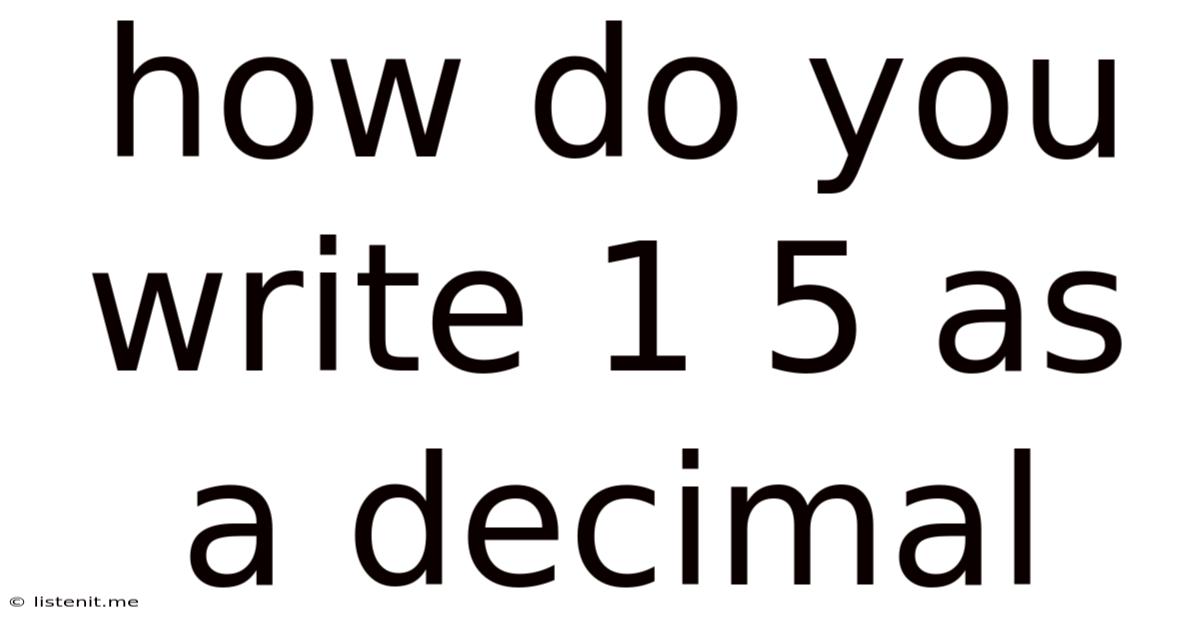How Do You Write 1 5 As A Decimal
listenit
May 09, 2025 · 4 min read

Table of Contents
How Do You Write 1 5 as a Decimal? A Comprehensive Guide
Converting fractions to decimals is a fundamental skill in mathematics, applicable across various fields, from everyday calculations to complex scientific computations. This comprehensive guide will delve into the method of converting the fraction 1/5 into its decimal equivalent, explaining the process step-by-step and exploring related concepts to solidify your understanding.
Understanding Fractions and Decimals
Before diving into the conversion, let's refresh our understanding of fractions and decimals.
Fractions represent parts of a whole. They consist of a numerator (the top number) and a denominator (the bottom number). The numerator indicates the number of parts you have, while the denominator indicates the total number of parts the whole is divided into. For example, in the fraction 1/5, 1 is the numerator and 5 is the denominator. This means we have one part out of a total of five equal parts.
Decimals are another way to represent parts of a whole. They use a base-10 system, where each place value to the right of the decimal point represents a power of 10 (tenths, hundredths, thousandths, and so on). For instance, 0.1 represents one-tenth, 0.01 represents one-hundredth, and so on.
Converting 1/5 to a Decimal: The Long Division Method
The most common method for converting fractions to decimals is long division. Here's how to apply it to 1/5:
-
Set up the long division: Write the numerator (1) inside the division symbol and the denominator (5) outside. It should look like this: 1 ÷ 5.
-
Add a decimal point and zeros: Since 5 doesn't go into 1, add a decimal point after the 1 and as many zeros as needed to the right. This doesn't change the value of the number; it simply allows for the division process. Now you have 1.000 ÷ 5.
-
Perform the long division: Begin dividing 5 into 1. 5 does not go into 1, so you put a 0 above the decimal point. Then, bring down the first zero after the decimal point to make 10. 5 goes into 10 twice (5 x 2 = 10), so you write a 2 above the first zero after the decimal point. Subtract 10 from 10, resulting in 0.
-
Continue the process (if necessary): In this case, the remainder is 0, meaning the division is complete. If there were a remainder, you would continue adding zeros and dividing until you either reach a remainder of 0 or a repeating pattern emerges.
Therefore, 1 ÷ 5 = 0.2
Alternative Methods for Converting 1/5 to a Decimal
While long division is a reliable method, other approaches can be used, especially for simpler fractions.
Method 1: Equivalent Fractions: This method involves finding an equivalent fraction with a denominator that is a power of 10 (10, 100, 1000, etc.).
In this case, we can easily multiply both the numerator and denominator of 1/5 by 2 to obtain 2/10. Since 2/10 means 2 tenths, it's directly represented as 0.2 in decimal form.
Method 2: Using a Calculator: Modern calculators can directly convert fractions to decimals. Simply input 1/5 and press the equals sign (=) to get the result: 0.2
Understanding Repeating and Terminating Decimals
When converting fractions to decimals, the result can be either a terminating decimal or a repeating decimal.
Terminating decimals have a finite number of digits after the decimal point. The decimal representation of 1/5, 0.2, is a terminating decimal.
Repeating decimals have a sequence of digits that repeat infinitely. For example, 1/3 converts to 0.3333... where the 3 repeats indefinitely. This is often represented as 0.$\overline{3}$.
Practical Applications of Decimal Conversions
The ability to convert fractions to decimals is crucial in various real-world scenarios:
-
Financial calculations: Calculating percentages, interest rates, and discounts often involve converting fractions to decimals.
-
Measurement and engineering: Many measurements use decimal systems, requiring conversion from fractional representations.
-
Scientific computations: Data analysis, statistical calculations, and various scientific models require converting fractions to decimals for easier manipulation.
-
Everyday situations: Dividing things fairly (e.g., splitting a pizza among friends) or understanding proportions (e.g., sale discounts) frequently involves converting fractions into decimals.
Beyond 1/5: Mastering Fraction-to-Decimal Conversions
The principles outlined for converting 1/5 to a decimal apply to other fractions as well. Here are some additional examples to practice:
-
1/2: Using long division or the equivalent fraction method (1/2 = 5/10 = 0.5) yields 0.5.
-
1/4: Long division or the equivalent fraction method (1/4 = 25/100 = 0.25) results in 0.25.
-
3/8: Long division would give you 0.375.
-
1/3: This results in a repeating decimal: 0.333... or 0.$\overline{3}$.
-
2/7: This also results in a repeating decimal: 0.285714285714... or 0.$\overline{285714}$.
By mastering these conversion techniques, you will improve your mathematical proficiency and confidently tackle various problems requiring the interchange between fractions and decimals. Remember to practice regularly, and don't hesitate to use different methods to enhance your understanding and find the approach that works best for you. The more you practice, the faster and more accurately you will be able to convert fractions to decimals. This skill is invaluable in many areas of life and study.
Latest Posts
Latest Posts
-
Definition Of Converse Of The Pythagorean Theorem
May 09, 2025
-
What Temperature Does Water Freeze In Kelvin
May 09, 2025
-
Equation Of A Line That Is Parallel To
May 09, 2025
-
Size Of The Universe In Meters
May 09, 2025
-
7 8 Divided By 3 4 As A Fraction
May 09, 2025
Related Post
Thank you for visiting our website which covers about How Do You Write 1 5 As A Decimal . We hope the information provided has been useful to you. Feel free to contact us if you have any questions or need further assistance. See you next time and don't miss to bookmark.